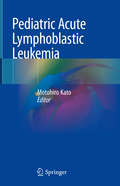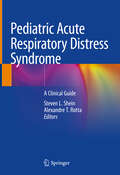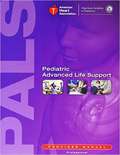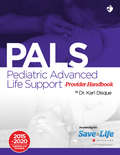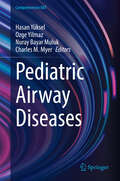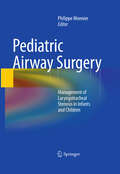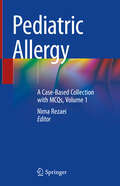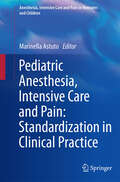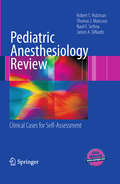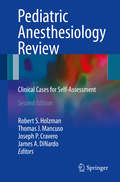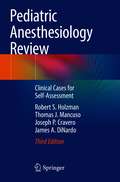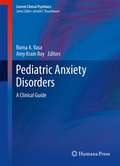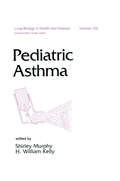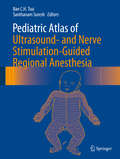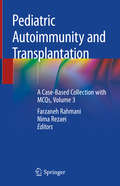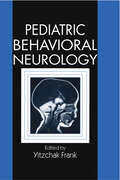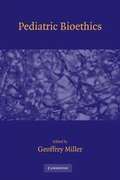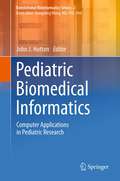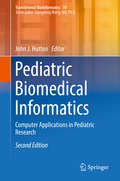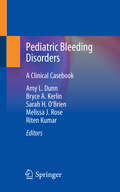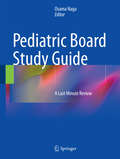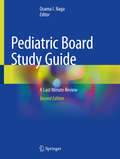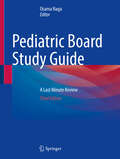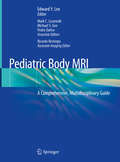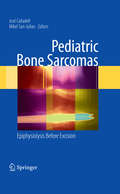- Table View
- List View
Pediatric Acute Lymphoblastic Leukemia
by Motohiro KatoThis book discusses key aspects of childhood acute lymphoblastic leukemia (ALL), presenting the latest research on the biology and treatment of the disease and related issues. The cure rate for ALL has improved dramatically due to advances such as supportive care, treatment stratification based on relapse risk, and the optimization of treatment regimens. Gathering contributions by eminent scholars Pediatric Acute Lymphoblastic Leukemia is a valuable resource for pediatric hematologists as well as for medical students, interns, residents and fellows. It not only offers comprehensive insights, but also provides a springboard for future research.
Pediatric Acute Respiratory Distress Syndrome: A Clinical Guide
by Steven L. Shein Alexandre T. RottaThis book provides a concise yet comprehensive overview of pediatric acute respiratory distress syndrome (PARDS). The text reviews the emerging science behind the new PARDS definition; explores epidemiology, pathobiology, etiologies, and risk factors; reviews state-of-the-art treatment modalities and strategies; and discusses clinical outcomes.Written by experts in the field, Pediatric Acute Respiratory Distress Syndrome: A Clinical Guide is a valuable resource for clinicians and practitioners who specialize in pediatric critical care.
Pediatric Advanced Life Support Provider Manual
by Mary Fran Hazinski Leon Chameides Ricardo A. Samson Stephen M. SchexnayderThis is the student text for the classroom-based Pediatric Advanced Life Support (PALS) course.
Pediatric Advanced Life Support: Provider Handbook
by Dr Karl DisqueThe Save a Life Initiative has just released its newest course: Pediatric Advanced Life Support (PALS). This manual is based on the 2015-2020 Pediatric Advanced Life Support guidelines published by the American Heart Association. The Pediatric Advanced Life Support (PALS) Provider Handbook is a comprehensive resource intended for health care professionals currently enrolled in a Pediatric Advanced Life Support Certification or Recertification Course. It serves as the primary training material for PALS Certification and Recertification courses. Although it is primarily intended for use during certification courses, the handbook was also created to serve as daily reference material for health care professionals. Information covered in the handbook includes EKG and electrical therapy review, pediatric respiratory failure and more. Specific PALS Algorithms and more are also included within the handbook. All material included in this handbook is delivered in a manner meant to enhance learning in the most comprehensive and convenient way possible.
Pediatric Airway Diseases (Comprehensive ENT)
by Nuray Bayar Muluk Hasan Yüksel Ozge Yilmaz Charles M. MyerThis book offers a comprehensive overview of airway diseases in children and their treatment by combining the expertise of ENT and Pediatric Pulmonology. Organized into six sections, it opens with general concepts of the upper respiratory tract for pediatric pulmonology before covering diagnostic testing. The third section explores the symptoms and signs related to upper and lower respiratory tract diseases. Section 4 focuses on Pediatric Pulmonology Disease-Specific Upper Respiratory Tract Involvement, whereas Section 5 is devoted to infectious diseases of the pediatric airway. Section 6 reviews surgical interventions for upper airway management. Each chapter provides full coverage of the topic at hand and includes fundamental information as well as updated insights. The international authorship ensures a wide range of perspectives and expertise. With its in-depth coverage and expert contributors, this book will broaden the understanding of pediatric airway diseases and meet the needs of ENT and pediatrics trainees and students, as well as ENT practitioners, pediatricians, and pulmonologists.
Pediatric Airway Surgery
by Philippe MonnierThis book provides detailed insight into the difficult problem of pediatric airway management. Each chapter focuses on a particular condition in a very practical manner, describing diagnostic procedures and precisely explaining surgical options with the help of high-quality illustrations. Both established treatment modalities and new management concepts are considered in depth, and controversies relating to the most difficult airway reconstructions are discussed. To help the reader, boxes are included to summarize procedures and to list tips, tricks, and traps relevant to daily practice. The contributors to the book have all been directly involved in the management of children with airway disorders and write on the basis of their vast experience. Otolaryngologists, pediatric surgeons, and thoracic surgeons involved in the management of pediatric airway problems, and in particular airway stenosis, will find this book to be a treasure trove of invaluable information and guidance.
Pediatric Allergy: A Case-Based Collection with MCQs, Volume 1
by Nima RezaeiThis book comprises a collection of case-based chapters, submitted by physicians and pediatricians in all specialties and meticulously refined and selected to cover the most common and important aspects of Pediatric Allergy knowledge. Commonly encountered disorders such as allergic rhinitis, food allergy, and atopic dermatitis are covered among many others. Each chapter starts with a brief of the initial presentation and lab data of the patient, followed by a series of 3-6 multiple choice questions (MCQs), leading the reader to the diagnosis and best of practice in a step-wise manner. Clinical pearls presented as "practical points", and the MCQ format along with detailed answers, makes Pediatrc Allergy an essential reading material that a pediatric allergologist cannot afford to miss.
Pediatric Anesthesia, Intensive Care and Pain: Standardization in Clinical Practice
by Marinella AstutoThis book provides a comprehensive overview of current standards of anesthesia and intensive care in neonates and children, with a view to promoting standardization in clinical practice. The first part of the book, devoted to issues in intensive care, opens by considering scoring systems for the assessment of sick children. The diagnosis, prevention, and management of ventilator-associated pneumonia are then discussed, and the roles of high-frequency oscillatory ventilation and noninvasive respiratory support are reviewed. Further chapters address procedural sedation and analgesia in children, the progress toward 'open' ICUs with liberal visiting policies, and advances in long-term home mechanical ventilation. In the second part of the book, a range of important topics in anesthesia and perioperative medicine are discussed. After a review of safety issues, current trends in pediatric regional and locoregional anesthesia are described and a synopsis is provided on current knowledge regarding the use of central blocks in infants and children. Subsequent chapters are devoted to awareness monitoring, single-lung ventilation techniques, anesthesia in the context of severe prematurity, and emergence delirium. Pediatric Anesthesia, Intensive Care and Pain: Standardization in Clinical Practice will be an extremely useful source of information for both novices and more experienced practitioners in the field.
Pediatric Anesthesiology Review
by James A. Dinardo Robert S. Holzman Navil F. Sethna Thomas J. MancusoBased on a program of study developed at the Children's Hospital Boston, Department of Anesthesiology, Perioperative and Pain Medicine, Pediatric Anesthesiology Review: Clinical Cases for Self-Assessment provides essential medical information for the subspecialty of pediatric anesthesiology. Illustrating the broad spectrum of the pediatric anesthesiologist's practice, this book utilizes an interactive question and answer dialogue which imitates the simplicity of conversation and affords the reader high-yield benefits. The case-based approach encourages readers to collaborate with colleagues, improve their oral presentation skills, and prepare for challenging situations by explaining various anesthesia care plans and why specific data are required before and during the care of the pediatric patient. Written by a panel of specialists recognized internationally for their efforts in their respective areas within pediatric anesthesia and examiners for various medical specialty boards including the American Board of Anesthesiology, this self-assessment programmed text for residents, fellows, and clinicians in the field of pediatric anesthesiology offers extremely valuable advice. The ability to explain why, in addition to how, is central to the Children's Hospital Boston program's philosophy, and Pediatric Anesthesiology Review: Clinical Cases for Self-Assessment maintains this ideal in the crafting of this book. An interactive question and answer program is featured on extras.springer.com.
Pediatric Anesthesiology Review
by James A. Dinardo Robert S. Holzman Thomas J. Mancuso Joseph P. CraveroThis text is designed for those who may become consultants in pediatric anesthesia. It is based on a curriculum developed since 1992 to illustrate the breadth and depth of the practice of pediatric anesthesia and the program is an integral part of the didactic series in the Department of Anesthesiology, Perioperative and Pain Medicine at Boston Children's Hospital. This second edition has the same purpose as the first - to accompany the reader's journey in attaining proficiency, expertise and finally, mastery in pediatric anesthesiology. The format of the book is designed to encourage the readers' free flow of ideas and the written examinations, seen at the beginning of the text as a baseline in pediatric medicine, are primarily knowledge-based, reflecting factual medical information necessary for the subspecialty practice of pediatric anesthesiology. With this basic guidance, the reader can bring him or herself "into the operating room" and manage the patient in an expert fashion.
Pediatric Anesthesiology Review: Clinical Cases for Self-Assessment
by Robert S. Holzman Thomas J. Mancuso Joseph P. Cravero James A. DiNardoThis book functions as a workbook for consultants in pediatric anesthesia. Based on a curriculum developed at the Boston Children’s Hospital Department of Anesthesiology, the content illustrates the breadth and depth of the practice of pediatric anesthesia. Organized into two parts, the book seeks to provide a sense of progression and feedback using clinical scenarios to aid the medical professional in developing autonomy, while preserving the availability of expert level discussion. Each chapter features self-assessments in question and answer format, and encourages the reader to be creative in their responses by invoking not only their clinical knowledge, but their philosophical views of pediatric anesthesia practice as well. Practical and accessible, The Pediatric Anesthesiology Review is an essential resource for those looking to attain proficiency, expertise, and mastery in pediatric anesthesiology.
Pediatric Anxiety Disorders: A Clinical Guide
by Amy Krain Roy Roma A. VasaOver the past decade, significant advances in research methodology have stimulated dramatic progress in the field of child psychiatry in general, and in pediatric anxiety disorders, more specifically. Pediatric Anxiety Disorders: A Clinical Guide is a comprehensive and vital addition to the literature at an exciting time in the field of psychiatry. This state-of-the-art reference aims to bridge the most up-to-date research findings with relevant clinical perspectives, making it a unique and essential resource for established clinicians and researchers, as well as for students and trainees. The book is organized into four sections, each of which includes chapters on a specific area of interest. The first section reviews the current research regarding etiological mechanisms of pediatric anxiety. The second section provides in-depth descriptions of the anxiety disorders that affect children and adolescents. The third section summarizes the literature on empirically supported assessment tools and evidence based cognitive-behavioral and pharmacological interventions. Of special practical note, the authors of these chapters have included comprehensive summary tables that can serve as quick reference tools. The final section of the text is dedicated to understanding how anxiety manifests in two special populations, children with chronic medical illnesses and those with autism spectrum disorders. Pediatric Anxiety Disorders: A Clinical Guide is an authoritative new volume developed by a renowned collection of clinicians and researchers in the field of childhood anxiety disorders.
Pediatric Asthma (Lung Biology in Health and Disease)
by Shirley J. Murphy H. William KellyAn up-to-the-minute reference guide for health professionals confronting pulmonary disorders in children, Pediatric Asthma offers the latest findings on this classification-defying disease and related conditions. Written by more than 20 international experts in the field, the book focuses on drug administration-issues of compliance, aerosol deliver
Pediatric Atlas of Ultrasound- and Nerve Stimulation-Guided Regional Anesthesia
by Ban C.H. Tsui Santhanam SureshThis is the first comprehensive text-atlas that shows how to use ultrasound technology and nerve stimulation techniques to guide regional blockade in children. Clinical chapters follow a sequential, highly illustrated format that provides step-by-step guidance and include cases, clinical pearls, and troubleshooting tips. Nearly 400 figures, consisting of ultrasound images, MRI images, and schematics, have been assembled to maximize understanding of pediatric neuroanatomy and its relationship to surrounding anatomical structures. To help the novice user, the book features side-by-side presentation of unlabeled and labeled ultrasound images. Pediatric Atlas of Ultrasound- and Nerve Stimulation-Guided Regional Anesthesia focuses on common approaches, supplemented in clinical pearls and notes by alternative approaches, and emphasizes dynamic and systematic scanning techniques. It is intended for pediatric anesthesiologists who wish to incorporate regional blockade into their repertoire and designed as a refresher and resource for all regional anesthesiologists seeking to refine their skills. Unique Selling Points: Internationally renowned experts Presents two technologies proven to improve block success when used together Superb coverage of pediatric anatomy in relation to regional anesthesia Equipment, set-up, pain assessment, local anesthetic pharmacology, and patient safety considerations f or child patients
Pediatric Autoimmunity and Transplantation: A Case-Based Collection with MCQs, Volume 3
by Nima Rezaei Farzaneh RahmaniThis book is a collection of case-based questions, directed towards and meticulously selected to cover the most common and important aspects of pediatric autoimmune disorders. Autoimmune disorders of infancy and childhood, rheumatological disorders, dermatologic autoimmune disorders, autoinflammatory disorders, and clinical immunology in solid organ and hematopoietic stem cell transplantation are among the topics covered. Each chapter starts with a case description followed by a series of 5-6 multiple choice questions (MCQ), presenting the flow from diagnosis to treatment in a step-wise, logical manner. The text guides the reader through the stream of real clinical practice from initial presentation, differential diagnosis, next best step, lab data, and definitive diagnosis to management and adverse effects of therapy. This MCQ format along with precise, yet detailed answer ensure a quick, reality learning to the reader. The book provides a quick guide and hands-on learning experience for pediatricians, hematologists, immunologists, transplant specialists, pulmonologists, as well as PhD and post-graduate researchers around the world.
Pediatric Behavioral Neurology
by Yitzchak FrankThis book assembles, for the first time, information required for the recognition, understanding, and treatment of behavioral problems resulting from neurological conditions. Its focus is two-pronged: 1) on conditions where cognitive-behavioral manifestations are major symptoms, such as attention deficit hyperactivity disorder, autism, and developmental language disorder; and 2) on conditions where these symptoms are significant but secondary, such as brain tumors, epilepsy, and AIDS. This multi-authored guide also outlines effective approaches to behavioral therapy for these conditions. Pediatric Behavioral Neurology is an excellent resource for practitioners whose work demands knowledge of the symptoms, signs, and treatment of behavioral and cognitive disorders caused by brain abnormalities. It is comprehensive, yet concise and easy to use.
Pediatric Bioethics
by Geoffrey MillerThis volume offers a theoretical and practical overview of the ethics of pediatric medicine. It serves as a fundamental handbook and resource for pediatricians, nurses, residents in training, graduate students, and practitioners of ethics and healthcare policy. Written by a team of leading experts, Pediatric Bioethics addresses those difficult ethical questions concerning the clinical and academic practice of pediatrics, including an approach to recognizing boundaries when confronted with issues such as end of life care, life-sustaining treatment, extreme prematurity, pharmacotherapy, and research. Thorny topics such as what constitutes best interests, personhood, or distributive justice and public health concerns such as immunization and newborn genetic screening are also addressed.
Pediatric Biomedical Informatics
by John J. HuttonAdvances in the biomedical sciences, especially genomics, proteomics, and metabolomics, taken together with the expanding use of electronic health records, are radically changing the IT infrastructure and software applications needed to support the transfer of knowledge from bench to bedside. Pediatric Biomedical Informatics: Computer Applications in Pediatric Research describes the core resources in informatics necessary to support biomedical research programs and how these can best be integrated with hospital systems to receive clinical information that is necessary to conduct translational research.The focus is on the authors' recent practical experiences in establishing an informatics infrastructure in a large research-intensive children's hospital. This book is intended for translational researchers and informaticians in pediatrics, but can also serve as a guide to all institutions facing the challenges of developing and strengthening informatics support for biomedical research. The first section of the book discusses important technical challenges underlying computer-based pediatric research, while subsequent sections discuss informatics applications that support biobanking and a broad range of research programs. Pediatric Biomedical Informatics provides practical insights into the design, implementation, and utilization of informatics infrastructures to optimize care and research to benefit children. Dr. John Hutton is the Vice President and Director of Biomedical Informatics at Cincinnati Children's Hospital Medical Center, Cincinnati, OH, USA. He is also Professor of Pediatrics and Associate Dean for Information Services at the University of Cincinnati College of Medicine.
Pediatric Biomedical Informatics
by John J. HuttonThe book describes the core resources in informatics necessary to support biomedical research programs and how these can best be integrated with hospital systems to receive clinical information that is necessary to conduct translational research. The focus is on the authors' recent practical experiences in establishing an informatics infrastructure in a large research-intensive children's hospital. This book is intended for translational researchers and informaticians in pediatrics, but can also serve as a guide to all institutions facing the challenges of developing and strengthening informatics support for biomedical research. The first section of the book discusses important technical challenges underlying computer-based pediatric research, while subsequent sections discuss informatics applications that support biobanking and a broad range of research programs. Pediatric Biomedical Informatics provides practical insights into the design, implementation, and utilization of informatics infrastructures to optimize care and research to benefit children.
Pediatric Bleeding Disorders: A Clinical Casebook
by Amy L. Dunn Bryce A. Kerlin Sarah H. O’Brien Melissa J. Rose Riten KumarThis clinical casebook provides a concise, state-of-the-art review of pediatric bleeding disorders. Presented in a case-based format, each case presents a different variant of bleeding disorder, illustrates the etiology, pathology, genetics, diagnosis, and management of the disorder, and offers clinical pearls. Disorders covered include hemophilia A and B, rare factor deficiencies, von Willebrand disease, immune thrombocytopenia purpura, and platelet dysfunctions. Written by experts in the field, Pediatric Bleeding Disorders: A Clinical Casebook is a valuable resource for clinicians and practitioners treating patients with challenging coagulation issues.
Pediatric Board Study Guide
by Osama NagaCovers the most frequently asked and tested points on the pediatric board exam. Each chapter offers a quick review of specific diseases and conditions clinicians need to know during the patient encounter. Easy-to-use and comprehensive, clinicians will find this guide to be the ideal final resource needed before taking the pediatric board exam.
Pediatric Board Study Guide: A Last Minute Review
by Osama I. NagaBuilding upon the highly successful 1st edition, this book is a comprehensive review designed to prepare pediatric residents, fellows, and pediatricians for the General Pediatrics Certifying Examination, and for the American Board of Pediatrics Maintenance of Certification. Pediatric Board Study Guide: A Last Minute Review, 2nd edition, covers all aspects of pediatric medicine; each chapter has been updated according to the most recent content specifications provided by the ABP. The 2nd edition provides more illustrations, diagrams, radiology images, and clinical case scenarios to further assist readers in reviewing pediatric subspecialties. New chapter topics include nutrition, sports medicine, patient safety, quality improvement, ethics, and pharmacology. Finally, the book closes with a “Last Minute Review” of high-yield cases arranged in the same sequence as the chapters, providing readers with a concise study guide of critical cases and conditions.Pediatric residents and fellows preparing for the board examination, pediatricians, and pediatric subspecialists preparing for certification maintenance will find Pediatric Board Study Guide: A Last Minute Review, 2nd edition easy to use and comprehensive, making it the ideal resource and study tool.
Pediatric Board Study Guide: A Last Minute Review
by Osama NagaThe second edition of this text has proved to be a very successful pediatric study guide, helping many pediatricians around the world to study pediatrics in a very easy, simplified way. Even the most complex subjects are condensed into very straight forward and easy to remember information blocks. This book not only prepares students to pass their exams but also prepares pediatricians for general pediatric encounters, emphasizing all new updates from the American Academy of Pediatrics and American Board of Pediatrics. It has proved very popular among new pediatricians and new pediatric residents worldwide. In the last 3 years, the AAP and ABP have released a lot of updates, such as, management of fever in well-appearing infants, COVID-19, asthma management, and new vaccine guidelines from the CDC. The pediatric board exam always includes new diseases, which are included in each chapter, as well as new questions and answers that must be added to the last-minute review chapter, as well as other questions to be edited to follow the new recommendations and guidelines in pediatrics. New pictures and better quality illustrations are also included. Pediatric residents and fellows preparing for the board examination, pediatricians, and pediatric subspecialists preparing for certification maintenance will find Pediatric Board Study Guide: A Last-Minute Review, 3rd edition, easy to use and comprehensive, making it the ideal resource and study tool.
Pediatric Body MRI: A Comprehensive, Multidisciplinary Guide (The\clinics: Radiology Ser. #51-4)
by Edward Y. Lee Mark C. Liszewski Michael S. Gee Pedro Daltro Ricardo RestrepoThis book is a unique, authoritative and clinically oriented text on pediatric body MRI. It is your one-step reference for current information on pediatric body MRI addressing all aspects of congenital and acquired disorders. The easy-to-navigate text is divided into 17 chapters. Each chapter is organized to comprehensively cover the latest MRI techniques, fundamental embryology and anatomy, normal development and anatomic variants, key clinical presentation, characteristic imaging findings with MRI focus, differential diagnosis and pitfalls, as well as up-to-date management and treatment. Written by internationally known pediatric radiology experts and editorial team lead by acclaimed author, Edward Y. Lee, MD, MPH, this book is an ideal guide for practicing radiologists, radiology trainees, MRI technologists as well as clinicians in other specialties who are interested in pediatric body MRI.
Pediatric Bone Sarcomas
by José Cañadell Mikel San-JulianThis technique was devised in Pamplona more than 20 years ago in 1984. However it took a long time for anything to be actually published (J Bone Joint Surg, 1994) because none believed it was really possible to preserve the joint of the patient. As time has gone on, the technique has aroused an outstanding amount of interest among doctors dealing with bone tumors. Nowadays there are people starting to employ the technique in several countries, and there are many doctors wanting to learn about it. With considerable experience now in the application of this technique, and great interest from many professionals from all over the world, the time is right for a comprehensive rundown of these ideas which will help many children who would otherwise almost certainly be amputated.
